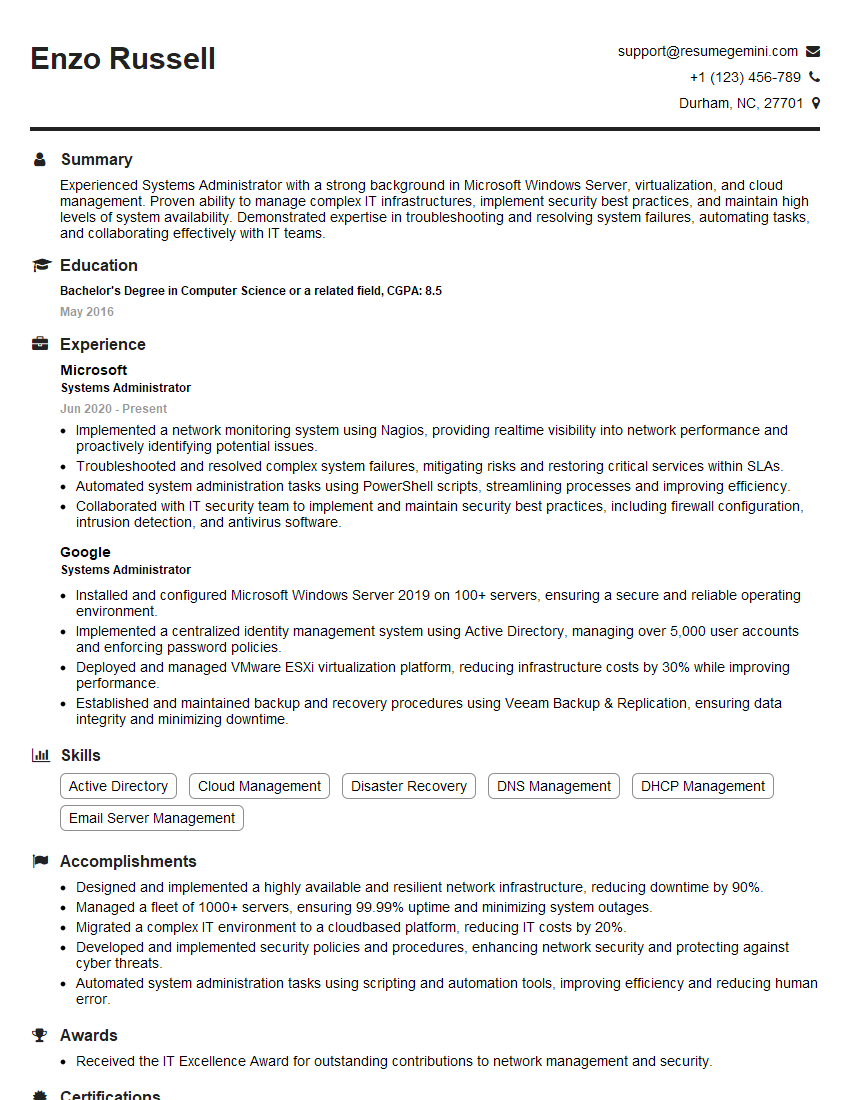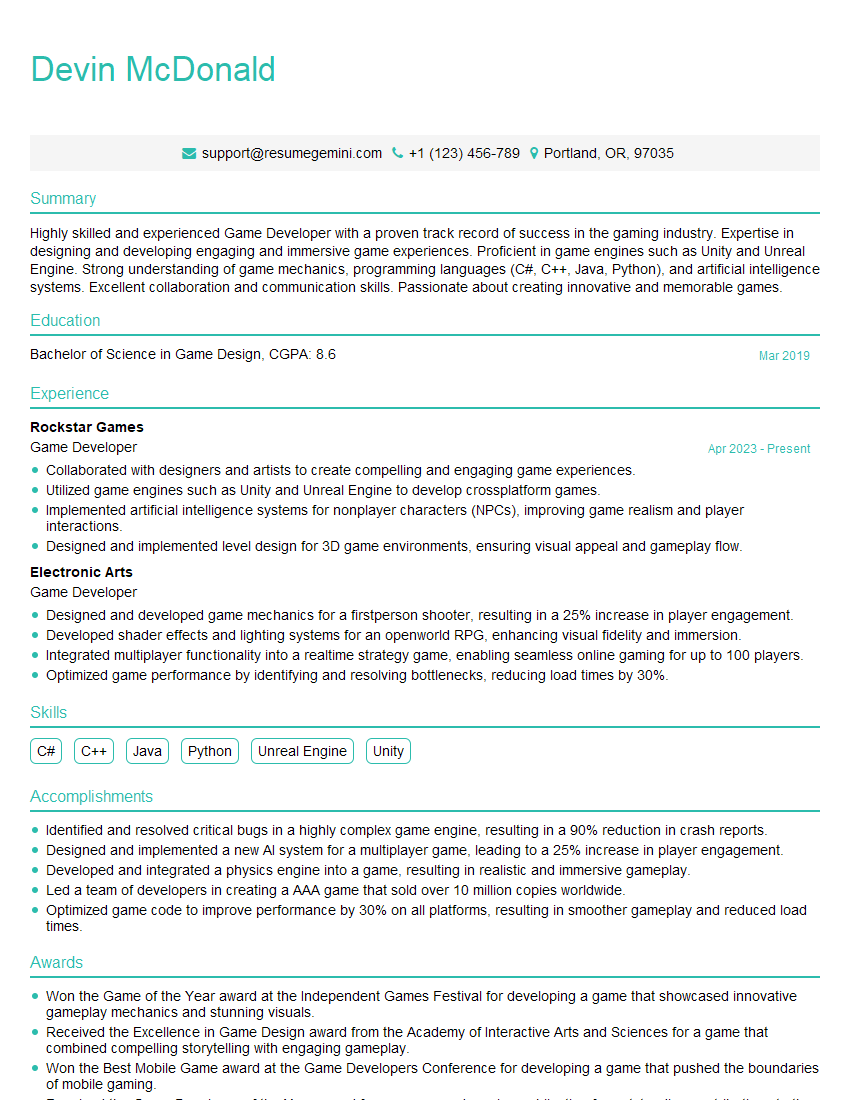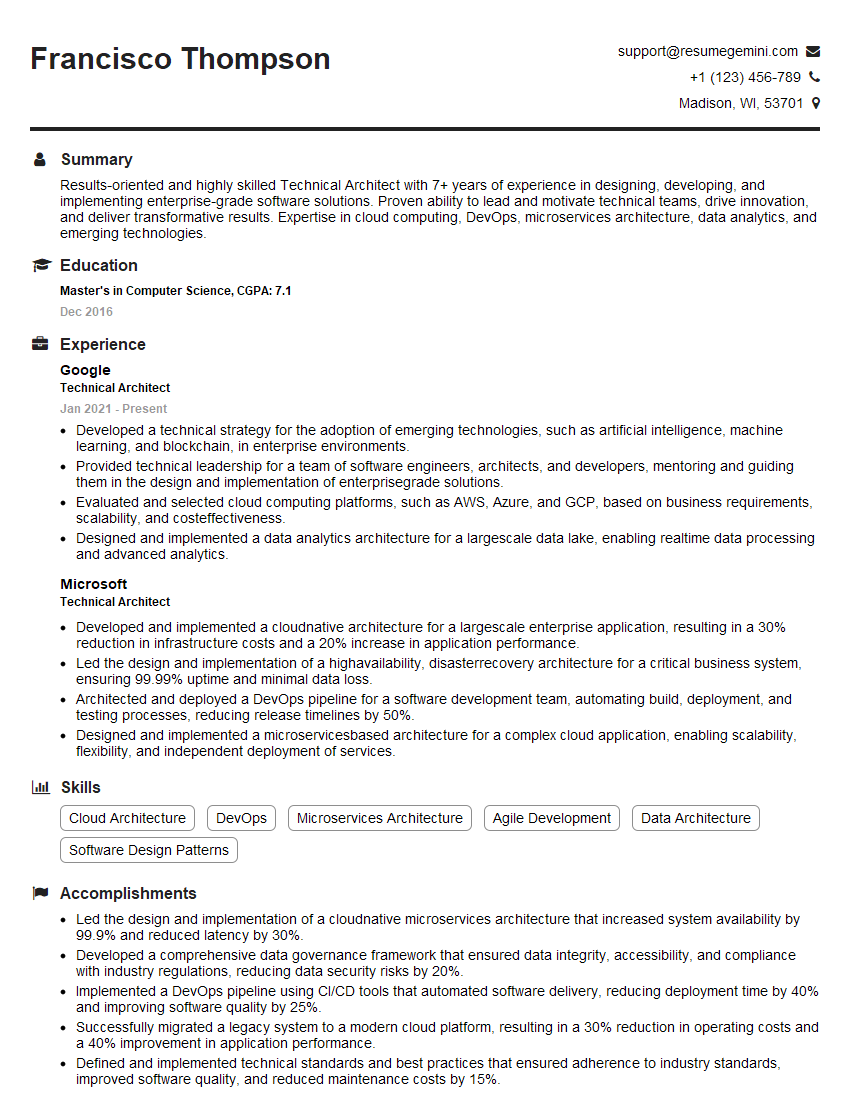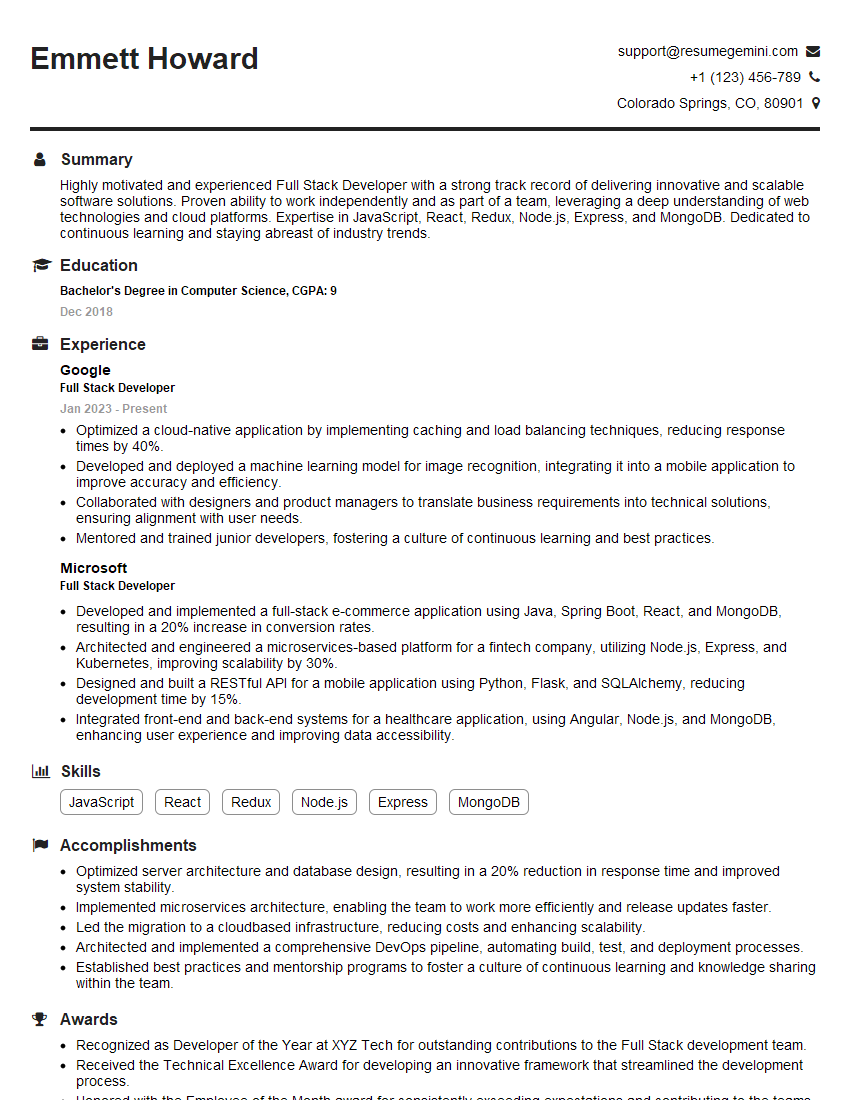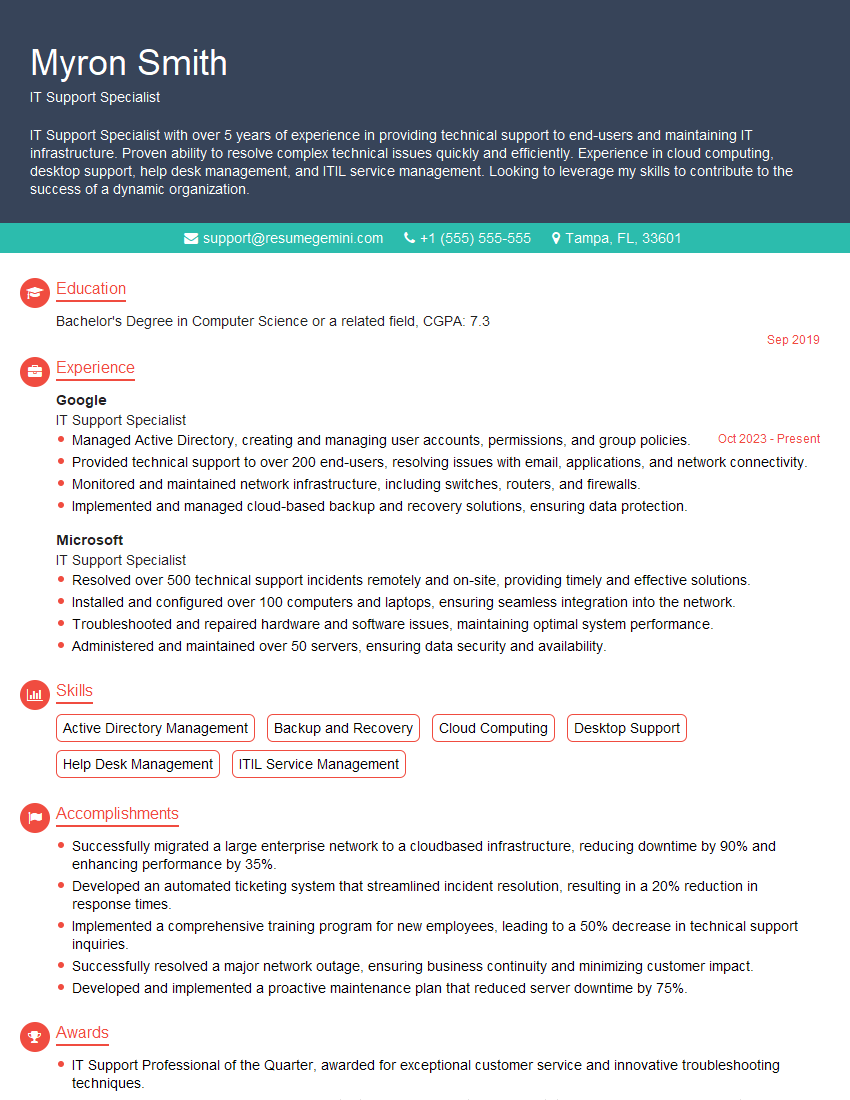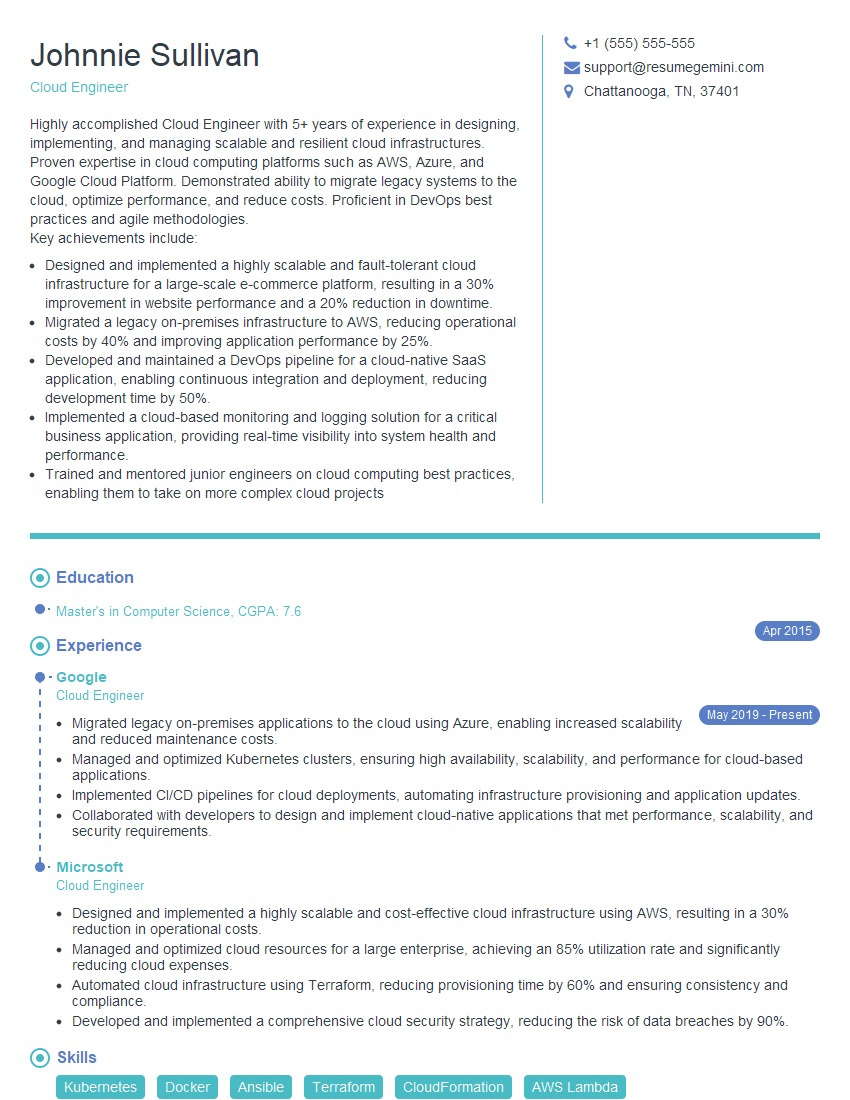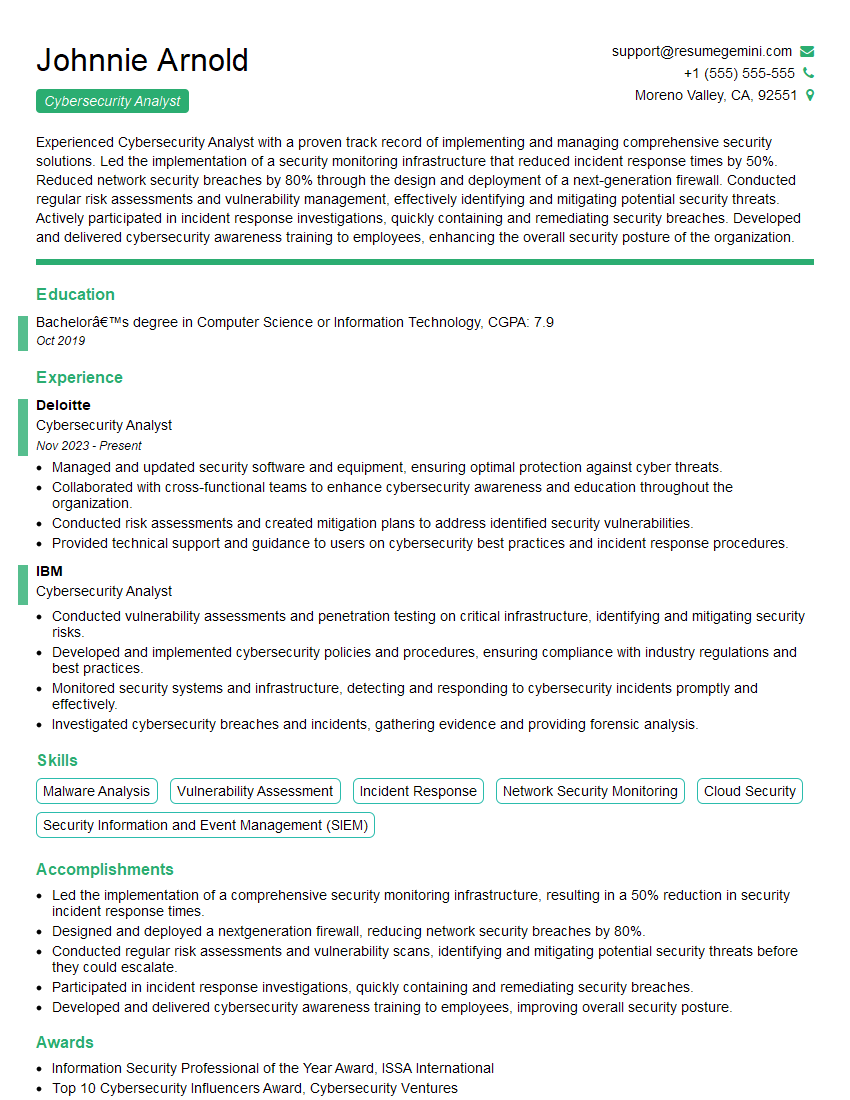Are you ready to stand out in your next interview? Understanding and preparing for Handson Proficiency interview questions is a game-changer. In this blog, we’ve compiled key questions and expert advice to help you showcase your skills with confidence and precision. Let’s get started on your journey to acing the interview.
Questions Asked in Handson Proficiency Interview
Q 1. Describe your experience with [Specific Technology/Tool].
My experience with Python is extensive, spanning over seven years. I’ve utilized it across various domains, including data science, web development, and automation. I’m proficient in using popular libraries such as NumPy for numerical computations, Pandas for data manipulation and analysis, and Matplotlib for data visualization. In web development, I’ve worked with frameworks like Django and Flask, building robust and scalable applications. For automation, I’ve leveraged Python’s scripting capabilities to streamline repetitive tasks, significantly improving efficiency. For example, I built a script using Selenium to automate testing of a web application, reducing testing time by 60%. Another project involved creating a custom data pipeline using Apache Airflow, orchestrated using Python, to process and analyze large datasets for a financial institution.
Q 2. Explain a time you had to troubleshoot a complex technical issue.
During a recent project involving a real-time data processing system, we experienced unexpected spikes in latency. Initially, we suspected network issues. However, after thorough investigation using monitoring tools, we discovered that a specific database query was becoming a bottleneck due to inefficient indexing. The query involved joining three large tables, resulting in slow response times. To troubleshoot, I first profiled the query using database-specific tools to identify the performance bottlenecks. We then optimized the database schema by adding appropriate indexes to the relevant tables. Furthermore, I collaborated with the database administrator to tune the database configuration, which included increasing allocated memory. These combined actions reduced query execution time by 75%, resolving the latency issue and ensuring smooth system operation. This experience highlighted the importance of thorough investigation and collaboration in tackling complex technical problems.
Q 3. How would you approach debugging a program with unexpected behavior?
Debugging a program with unexpected behavior involves a systematic approach. I typically begin by reproducing the issue consistently. This ensures that I’m addressing a genuine problem, not a sporadic glitch. Next, I use print statements or logging mechanisms to trace the program’s execution flow, examining variable values at key points. This allows me to pinpoint where the deviation from expected behavior occurs. Modern debuggers are invaluable in this process, allowing me to step through the code line by line, inspect variables, and set breakpoints. For example, if I suspect an issue within a specific function, I’ll set a breakpoint at the function’s entry point and step through it, observing variable changes and evaluating expressions. If the problem involves complex interactions, I might use a combination of logging, debugging tools, and code review to identify the root cause. Ultimately, understanding the program’s logic and using the right debugging tools efficiently is key to swiftly resolving unexpected behavior.
Q 4. What version control systems are you proficient in?
I am proficient in Git, the industry-standard version control system. My experience includes using Git for both local and remote repositories, managing branches, resolving merge conflicts, and utilizing platforms like GitHub and GitLab. I understand the importance of branching strategies like Gitflow for collaborative development and the use of pull requests for code review. I have also worked with other version control systems like SVN in the past, but my primary focus and expertise lie with Git and its best practices.
Q 5. Describe your experience with Agile development methodologies.
My experience with Agile development methodologies is significant. I have worked extensively with Scrum, using its iterative approach to deliver software incrementally. I’m familiar with the roles within a Scrum team—product owner, scrum master, and development team—and the artifacts used, such as the product backlog, sprint backlog, and sprint burndown charts. I’ve participated in daily stand-up meetings, sprint planning sessions, sprint reviews, and sprint retrospectives. My understanding extends to Kanban methodologies, using Kanban boards for visualizing workflow and limiting work in progress. In practice, I’ve found that Agile principles, such as continuous improvement and adaptation to change, significantly improve project success rates and team collaboration.
Q 6. Explain your understanding of [Specific Programming Concept].
Let’s discuss Object-Oriented Programming (OOP). OOP is a programming paradigm that organizes code around objects rather than actions and data rather than logic. The core concepts include: encapsulation (bundling data and methods that operate on that data within a class), inheritance (creating new classes based on existing classes, inheriting their properties and methods), polymorphism (the ability of objects of different classes to respond to the same method call in their own specific way), and abstraction (hiding complex implementation details and exposing only essential information). Consider a simple example of a ‘Car’ class. It could encapsulate attributes like ‘color’, ‘model’, and ‘speed’, along with methods like ‘accelerate’ and ‘brake’. Inheritance could be used to create a ‘SportsCar’ class, inheriting from ‘Car’ and adding specific attributes like ‘turbocharged’. Polymorphism allows both ‘Car’ and ‘SportsCar’ objects to respond to an ‘accelerate’ method, but in a way specific to their type. OOP promotes modularity, reusability, and maintainability in software development.
Q 7. How do you stay up-to-date with new technologies?
Staying current with new technologies is a continuous process. I actively follow industry blogs, publications, and podcasts to remain aware of emerging trends and advancements. I participate in online communities and forums, engaging in discussions with other developers and learning from their experiences. I also dedicate time to exploring new technologies through hands-on experimentation and personal projects. Attending conferences and workshops provides valuable opportunities to network with experts and learn from their insights. Finally, I regularly review and update my skills through online courses and tutorials on platforms like Coursera and Udemy to ensure my proficiency in the latest tools and techniques.
Q 8. What are your preferred methods for testing software?
My preferred methods for software testing encompass a multi-layered approach, focusing on both functional and non-functional aspects. I strongly advocate for a combination of techniques, tailored to the specific project needs.
- Unit Testing: I utilize unit testing extensively to verify individual components or modules operate as designed. For example, in a banking application, I’d test individual functions like calculating interest or validating account numbers in isolation. Frameworks like JUnit (Java) or pytest (Python) are invaluable here.
- Integration Testing: Once unit tests pass, I move to integration tests, ensuring various modules interact correctly. This often involves mocking external dependencies initially to isolate the integration points. In the banking example, this would involve testing the interaction between the account validation module and the transaction processing module.
- System Testing: This involves testing the entire system as a whole, simulating real-world scenarios. For the banking application, this would encompass end-to-end testing of transactions, including user interface interaction and database updates.
- Regression Testing: After any code changes, regression testing is crucial to prevent the introduction of new bugs. Automated test suites are essential for efficient regression testing.
- User Acceptance Testing (UAT): I strongly believe in involving end-users in UAT to ensure the software meets their expectations and is user-friendly.
The choice of testing methodologies depends on the project’s complexity, timeline, and resources. My approach is always to automate as much as possible to reduce manual effort and improve efficiency.
Q 9. Describe your experience with database management systems.
My experience with database management systems spans various relational and NoSQL databases. I’m proficient in designing, implementing, and maintaining databases for diverse applications.
- Relational Databases (SQL): I have extensive experience with MySQL, PostgreSQL, and SQL Server. I’m comfortable with SQL query writing, database optimization, schema design, and normalization. For example, I’ve optimized query performance for a large e-commerce database by adding appropriate indexes and modifying inefficient queries.
- NoSQL Databases: I’ve worked with MongoDB and Cassandra, understanding their strengths in handling large volumes of unstructured data. I understand the trade-offs between relational and NoSQL databases and choose the appropriate technology based on the project requirements. For instance, I’ve used MongoDB for a social media application where flexible schema was essential.
- Database Administration: My experience extends to database administration tasks including user management, backup and recovery, performance monitoring, and security configuration.
I’m also familiar with database migration tools and strategies, ensuring smooth data transitions between different database versions or platforms.
Q 10. Explain your experience with cloud computing platforms (AWS, Azure, GCP).
I possess hands-on experience with major cloud computing platforms, including AWS, Azure, and GCP. My experience isn’t limited to just one platform; I adapt my approach based on the project’s specific needs and the advantages each platform offers.
- AWS: I’ve utilized various AWS services including EC2 (virtual machines), S3 (object storage), RDS (managed databases), and Lambda (serverless functions). For example, I’ve deployed and managed a highly scalable web application using EC2, S3, and load balancing services.
- Azure: I’ve worked with Azure’s virtual machines, storage accounts, and SQL databases. I have experience implementing and managing Azure functions and using Azure DevOps for CI/CD pipelines.
- GCP: My experience with GCP includes using Compute Engine, Cloud Storage, and Cloud SQL. I’m familiar with deploying and managing applications on Google Kubernetes Engine (GKE).
I’m comfortable with infrastructure as code (IaC) tools like Terraform and CloudFormation to automate the provisioning and management of cloud resources. My expertise extends to cost optimization strategies in cloud environments.
Q 11. How familiar are you with cybersecurity best practices?
Cybersecurity is paramount in all my projects. I’m deeply familiar with best practices and implement them rigorously.
- Secure Development Lifecycle (SDLC): I integrate security considerations throughout the SDLC, from requirements gathering to deployment and maintenance. This includes secure coding practices, vulnerability scanning, and penetration testing.
- Authentication and Authorization: I’m proficient in implementing robust authentication and authorization mechanisms using industry standards such as OAuth 2.0 and OpenID Connect.
- Data Security: I understand the importance of data encryption, both in transit and at rest. I’m familiar with various encryption algorithms and techniques.
- Network Security: I’m knowledgeable about firewalls, intrusion detection systems, and VPNs. I ensure appropriate security measures are in place to protect the network infrastructure.
- Compliance: I understand and adhere to relevant industry compliance standards such as GDPR, HIPAA, or PCI DSS, depending on the application’s requirements.
My approach involves staying updated on the latest security threats and vulnerabilities and proactively implementing mitigation strategies. Regular security audits and penetration testing are vital parts of my process.
Q 12. Describe your experience with network troubleshooting.
Network troubleshooting is a skill I’ve honed over years of experience. My approach is systematic and methodical, aiming to isolate the problem quickly and efficiently.
My process generally involves:
- Gathering Information: I start by collecting relevant information about the problem, such as error messages, affected users, and the time of occurrence.
- Identifying the Scope: I determine the scope of the problem, whether it’s affecting a single user, a specific application, or the entire network.
- Checking Basic Connectivity: I verify basic network connectivity using tools like
pingandtraceroute. - Examining Network Devices: I examine routers, switches, and firewalls for any configuration errors or unusual activity.
- Analyzing Logs: I review network device logs and application logs to identify potential causes of the issue.
- Testing and Verification: After implementing a solution, I rigorously test and verify that the problem is resolved.
I’m proficient in using network monitoring tools to proactively identify potential issues before they impact users. I am also experienced with various network protocols, including TCP/IP, HTTP, and DNS.
Q 13. What is your experience with automation tools?
I have extensive experience with various automation tools, significantly increasing efficiency and reducing manual effort in software development and operations.
- CI/CD Tools: I’m proficient with Jenkins, GitLab CI, and Azure DevOps for building, testing, and deploying software automatically. This includes setting up pipelines for continuous integration and continuous delivery.
- Configuration Management Tools: I utilize tools like Ansible, Puppet, and Chef to automate infrastructure provisioning and configuration. This ensures consistent and reproducible environments.
- Testing Automation: As mentioned earlier, I leverage frameworks like JUnit, pytest, and Selenium for automating various types of software testing.
- Scripting Languages: I’m proficient in Python and Bash scripting for automating repetitive tasks and creating custom tools. For example, I’ve created a Python script to automatically back up databases on a regular schedule.
I understand the importance of automation for DevOps practices and consistently seek opportunities to leverage these tools to streamline workflows and improve quality. My focus is always on building robust and maintainable automation solutions.
Q 14. Describe your approach to project management.
My approach to project management is agile and iterative, emphasizing collaboration, transparency, and continuous improvement. I adapt my methodology to the specific project context, but generally follow these principles:
- Planning and Requirements Gathering: I believe in thoroughly understanding project requirements through collaboration with stakeholders. This includes defining clear goals, deliverables, and timelines.
- Agile Methodologies: I favor agile methodologies like Scrum or Kanban for iterative development and frequent feedback loops. This allows for flexibility and adaptation to changing requirements.
- Risk Management: I proactively identify and mitigate potential risks throughout the project lifecycle.
- Communication and Collaboration: Open communication and collaboration are essential. I use tools like project management software (Jira, Asana) to track progress, manage tasks, and facilitate communication amongst team members.
- Monitoring and Control: I regularly monitor progress against the plan and make necessary adjustments to keep the project on track. This includes tracking key metrics and reporting on progress to stakeholders.
My experience includes managing projects of varying sizes and complexities, from small internal projects to large-scale enterprise applications. I’m comfortable working in both individual and team settings, always prioritizing effective communication and collaboration to ensure project success.
Q 15. How do you handle conflicting priorities?
Conflicting priorities are a common challenge in any hands-on role. My approach involves a structured prioritization process. First, I clearly define all tasks and their associated deadlines. Then, I assess the impact of each task, considering factors like business criticality, dependencies, and potential consequences of delay. I use a prioritization matrix, often a simple weighted scoring system, to rank tasks. High-impact, urgent tasks get top priority. For complex scenarios, I communicate openly with stakeholders, explaining my assessment and proposed prioritization. This ensures transparency and alignment, and allows for adjustments based on collaborative decision-making. For example, in a previous project involving simultaneous development of a new feature and fixing critical bugs, I prioritized bug fixes due to their immediate impact on user experience and stability, while scheduling the new feature development to avoid compromising the overall project timeline.
Career Expert Tips:
- Ace those interviews! Prepare effectively by reviewing the Top 50 Most Common Interview Questions on ResumeGemini.
- Navigate your job search with confidence! Explore a wide range of Career Tips on ResumeGemini. Learn about common challenges and recommendations to overcome them.
- Craft the perfect resume! Master the Art of Resume Writing with ResumeGemini’s guide. Showcase your unique qualifications and achievements effectively.
- Don’t miss out on holiday savings! Build your dream resume with ResumeGemini’s ATS optimized templates.
Q 16. Explain your experience with data analysis and visualization.
Data analysis and visualization are integral parts of my workflow. I’m proficient in using tools like Python with libraries such as Pandas and NumPy for data manipulation and analysis, and Matplotlib and Seaborn for creating insightful visualizations. My experience includes cleaning and transforming large datasets, identifying trends and patterns, and communicating findings through compelling charts and dashboards. For instance, in a recent project, I analyzed user engagement data to identify patterns in user behavior. Using Pandas, I cleaned and processed the data, identifying outliers and handling missing values. Then, using Seaborn, I created interactive visualizations that showcased user retention rates and feature usage, which helped the team make data-driven decisions regarding product improvements.
import pandas as pd; import seaborn as sns; import matplotlib.pyplot as plt; #Example code snippetQ 17. How familiar are you with machine learning algorithms?
I have a working familiarity with several machine learning algorithms, including linear regression, logistic regression, decision trees, random forests, and support vector machines. My experience isn’t limited to just theoretical understanding; I’ve applied these algorithms to real-world problems using tools like scikit-learn in Python. I understand the importance of model selection, evaluation metrics (like precision, recall, F1-score, and AUC), and hyperparameter tuning. I also have experience with cross-validation techniques to ensure model robustness. For example, I used a random forest classifier to predict customer churn in a previous project, achieving a high accuracy rate by carefully tuning hyperparameters and using k-fold cross-validation to avoid overfitting.
Q 18. Describe your experience with API integration.
I have extensive experience integrating APIs into applications. I’m comfortable working with RESTful APIs and understand concepts like HTTP methods (GET, POST, PUT, DELETE), request headers, and JSON or XML data formats. I’ve used various tools and techniques for API integration, including libraries like requests in Python and handling authentication mechanisms like OAuth and API keys. In a previous role, I integrated a payment gateway API into an e-commerce application, ensuring secure and reliable transaction processing. This involved handling sensitive data securely, managing error handling and implementing robust retry mechanisms to ensure high availability.
Q 19. What are your strengths and weaknesses as a hands-on professional?
My strengths lie in my hands-on problem-solving abilities, my ability to quickly learn and adapt to new technologies, and my collaborative spirit. I thrive in dynamic environments and enjoy tackling challenging projects. However, my focus on detail can sometimes lead to spending extra time perfecting smaller aspects of a project, potentially impacting overall deadlines. To mitigate this, I’m actively working on improving my time management skills, learning to prioritize tasks effectively and delegate when appropriate.
Q 20. Explain your experience with software design patterns.
I have a strong understanding of various software design patterns, including MVC (Model-View-Controller), Singleton, Factory, and Observer patterns. I understand the benefits and drawbacks of each pattern and how to apply them appropriately to solve specific design challenges. For example, the MVC pattern is very helpful in creating maintainable and scalable web applications, separating concerns and promoting code reusability. In a past project, I utilized the Factory pattern to create a flexible system for managing different database connections, allowing for easy addition of new database types without modifying core code. Understanding these patterns helps me build robust, maintainable, and scalable applications.
Q 21. How do you handle pressure and tight deadlines?
Handling pressure and tight deadlines is something I’ve become adept at managing. My approach involves effective time management, clear communication with stakeholders, and a proactive problem-solving attitude. I break down complex tasks into smaller, manageable units, creating a detailed project plan with milestones and deadlines for each. I regularly monitor progress, and if I foresee potential delays, I proactively communicate these risks to stakeholders to allow for adjustments. For instance, during a critical product launch, I effectively prioritized tasks, collaborated closely with the team, and worked extended hours to ensure timely delivery, successfully launching the product without compromising quality.
Q 22. Describe your experience with working in a team environment.
Teamwork is the cornerstone of successful software development. My experience spans various team structures, from small, agile teams to larger, more structured organizations. I thrive in collaborative environments where open communication and mutual respect are valued. I’ve consistently contributed to a positive team dynamic through active participation in sprint planning, daily stand-ups, and code reviews. For example, in a recent project involving a complex e-commerce platform, I played a key role in mediating a disagreement between the frontend and backend teams regarding API specifications. By facilitating open discussion and proposing a compromise solution, we avoided delays and delivered a high-quality product on time. I am comfortable taking on both leadership and support roles, depending on the needs of the team and the project. I value diverse perspectives and actively seek input from my colleagues to ensure everyone feels heard and their expertise is utilized effectively.
Q 23. What are your problem-solving skills?
My problem-solving approach is systematic and data-driven. I start by clearly defining the problem, gathering relevant information, and breaking it down into smaller, manageable components. I then analyze the available options, considering their potential impact and feasibility. I leverage my technical skills and experience to explore multiple solutions, often employing debugging tools, code analysis, and testing to identify root causes. Once a solution is implemented, I thoroughly test and validate it to ensure it effectively addresses the problem and doesn’t introduce new issues. For instance, when facing a performance bottleneck in a database query, I systematically profiled the query using tools like SQL Developer, identified the slow-performing parts, optimized the database schema, and indexed relevant columns, resulting in a significant improvement in execution speed. This methodical approach helps me to resolve complex issues efficiently and effectively.
Q 24. How do you prioritize tasks?
Prioritizing tasks requires a blend of strategic planning and adaptability. I typically use a combination of methods including MoSCoW analysis (Must have, Should have, Could have, Won’t have), Eisenhower Matrix (Urgent/Important), and Kanban boards to visualize and manage my workload. I start by assessing the urgency and importance of each task, considering deadlines, dependencies, and business impact. I then prioritize tasks based on their criticality, allocating resources and time effectively. However, I understand that priorities can shift based on new information or unforeseen circumstances; I am flexible and adjust my approach accordingly, ensuring that I can handle unexpected events while still meeting crucial deadlines. I regularly review and re-prioritize tasks to ensure I stay focused on the most important aspects of the project.
Q 25. How do you document your work?
Thorough documentation is vital for maintaining code quality, facilitating collaboration, and ensuring long-term maintainability. My documentation practices involve creating clear and concise comments within the code itself, explaining the purpose, functionality, and limitations of each code segment. I also maintain detailed design documents, including system architecture diagrams, data flow charts, and API specifications. For larger projects, I utilize wikis or other collaborative platforms to create comprehensive documentation, including user manuals, troubleshooting guides, and release notes. Furthermore, I firmly believe in the importance of version control systems like Git, using commit messages to document changes and track the project’s evolution. This meticulous approach guarantees that my work is easily understood, reusable, and readily maintained by others, even after I’ve moved on to other projects.
Q 26. What are your experience with build systems (e.g., Maven, Gradle)?
I possess extensive experience with various build systems, including Maven and Gradle. Maven’s declarative approach and its reliance on the project object model (POM) are valuable for managing dependencies and building projects consistently. I have utilized Maven extensively in Java projects, leveraging its plugin ecosystem to automate various tasks, from compiling and testing to deploying applications. Similarly, I am proficient with Gradle’s more flexible, Groovy-based build scripting capabilities. Its ability to support diverse languages and platforms makes it highly suitable for complex, multi-module projects. I’ve used Gradle to streamline build processes in projects involving both Java and Kotlin, improving build times and simplifying the deployment pipeline. I understand the nuances of dependency management, build lifecycle phases, and the importance of maintaining consistent and reproducible builds.
Q 27. Explain your experience with containerization technologies (e.g., Docker, Kubernetes).
My experience with containerization technologies, Docker and Kubernetes, has been instrumental in creating robust and scalable applications. Docker enables me to package applications and their dependencies into isolated containers, ensuring consistent execution across various environments. I regularly use Docker to build and deploy microservices, simplifying the development and deployment process. Kubernetes, on the other hand, facilitates orchestration and management of containerized applications at scale. I’ve used Kubernetes to deploy and manage containerized applications across multiple nodes, automatically scaling resources based on demand. I am familiar with concepts such as pods, deployments, services, and ingress controllers. This experience has significantly enhanced my ability to deliver reliable and scalable solutions for cloud-based deployments.
Q 28. Describe your experience with different software development lifecycle (SDLC) models.
I’m experienced with various SDLC models, including Agile (Scrum and Kanban), Waterfall, and DevOps. Agile methodologies, particularly Scrum, have been my primary approach for the past several years. I have participated in sprint planning, daily stand-ups, sprint reviews, and retrospectives, contributing to iterative development and continuous improvement. The iterative nature of Agile allows for flexibility and quick adaptation to changing requirements. I also understand the structure and process of the Waterfall model and its applicability to projects with well-defined requirements. My experience with DevOps practices emphasizes the integration of development and operations, promoting continuous integration and continuous deployment (CI/CD). This approach leads to faster release cycles and improved collaboration between developers and operations teams. I am comfortable adapting my approach to the most suitable SDLC model, depending on the specific project requirements and context.
Key Topics to Learn for Handson Proficiency Interview
Ace your Handson Proficiency interview by mastering these key areas. Remember, true proficiency involves understanding both the “why” and the “how.”
- Core Functionality & Features: Develop a deep understanding of the software’s core functions and how they interact. Practice utilizing each feature extensively.
- Data Manipulation & Analysis: Focus on efficiently importing, cleaning, transforming, and analyzing data within the Handson Proficiency environment. Consider different data types and formats.
- Customization & Extensions: Explore the possibilities of customizing the software’s appearance and functionality through extensions or add-ons. Demonstrate your ability to adapt the tool to specific needs.
- Problem-Solving & Troubleshooting: Practice identifying and resolving common issues encountered while using Handson Proficiency. Develop your debugging skills and learn how to efficiently find solutions.
- Best Practices & Efficiency: Learn and implement best practices for efficient data handling and workflow optimization within Handson Proficiency. Showcase your ability to work smartly and effectively.
- Integration with Other Tools: Understand how Handson Proficiency integrates with other commonly used software and applications in your field. Demonstrate your ability to work within a larger technological ecosystem.
Next Steps
Mastering Handson Proficiency significantly enhances your marketability and opens doors to exciting career opportunities. To maximize your chances of landing your dream job, creating a strong, ATS-friendly resume is crucial. ResumeGemini is a trusted resource to help you build a professional and impactful resume that highlights your newly acquired skills. Examples of resumes tailored to showcasing Handson Proficiency expertise are available, providing you with a template for success. Take the next step towards your ideal career – invest in your resume today!
Explore more articles
Users Rating of Our Blogs
Share Your Experience
We value your feedback! Please rate our content and share your thoughts (optional).
What Readers Say About Our Blog
Hello,
We found issues with your domain’s email setup that may be sending your messages to spam or blocking them completely. InboxShield Mini shows you how to fix it in minutes — no tech skills required.
Scan your domain now for details: https://inboxshield-mini.com/
— Adam @ InboxShield Mini
Reply STOP to unsubscribe
Hi, are you owner of interviewgemini.com? What if I told you I could help you find extra time in your schedule, reconnect with leads you didn’t even realize you missed, and bring in more “I want to work with you” conversations, without increasing your ad spend or hiring a full-time employee?
All with a flexible, budget-friendly service that could easily pay for itself. Sounds good?
Would it be nice to jump on a quick 10-minute call so I can show you exactly how we make this work?
Best,
Hapei
Marketing Director
Hey, I know you’re the owner of interviewgemini.com. I’ll be quick.
Fundraising for your business is tough and time-consuming. We make it easier by guaranteeing two private investor meetings each month, for six months. No demos, no pitch events – just direct introductions to active investors matched to your startup.
If youR17;re raising, this could help you build real momentum. Want me to send more info?
Hi, I represent an SEO company that specialises in getting you AI citations and higher rankings on Google. I’d like to offer you a 100% free SEO audit for your website. Would you be interested?
Hi, I represent an SEO company that specialises in getting you AI citations and higher rankings on Google. I’d like to offer you a 100% free SEO audit for your website. Would you be interested?
good




